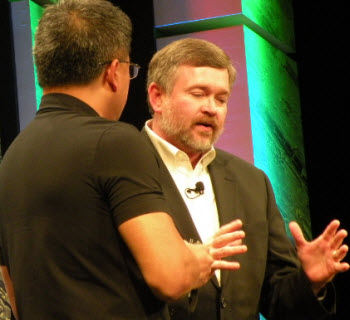 The Oak Ridge National Laboratory said today it will use Nvidia‘s next-generation graphics chips in a supercomputer that is 10 times more powerful than the lab’s fastest current machine.
The Oak Ridge National Laboratory said today it will use Nvidia‘s next-generation graphics chips in a supercomputer that is 10 times more powerful than the lab’s fastest current machine.
Jeff Nichols, associate lab director (pictured, right), said that Oak Ridge will use the Nvidia chip, code-namemd Fermi, which is evidently shipping in a matter of months. The announcement is a validation of an important part of Nvidia’s strategy. Jen-Hsun Huang, chief executive of Nvidia, said the company is designing its graphics chips to handle non-graphics functions. This is because the parallel computing processors on the graphics chips can be efficiently used to handle other work normally performed by microprocessors at slow processing speeds.
Huang calls this GPU computing, after graphics processing unit. For the past two years, Nvidia has been investing heavily in this technology, and the Fermi graphics chip will be the newest version. Oak Ridge will use the supercomputer to pursue research in energy issues and climate change.
This development is sure to make microprocessor vendors Intel and Advanced Micro Devices a little uncomfortable. Normally, supercomputers rely upon thousands of microprocessors. Now, with this hybrid graphics/microprocessor supercomputer, there could be one graphics chip for every microprocessor. The supercomputer is going to have huge performance at something like 20 petaflops. A petaflop is a thousand trillion operations per second.
Nvidia is hoping that wide adoption of its CUDA non-graphics programming environment and its GPU computing platform will help spread its graphics chips far and wide. Supercomputers are one application, but there are a bunch of others in the works as well. That’s why Nvidia is holding its GPU Technology conference in San Jose, Calif., this week for 1,500 researchers.



